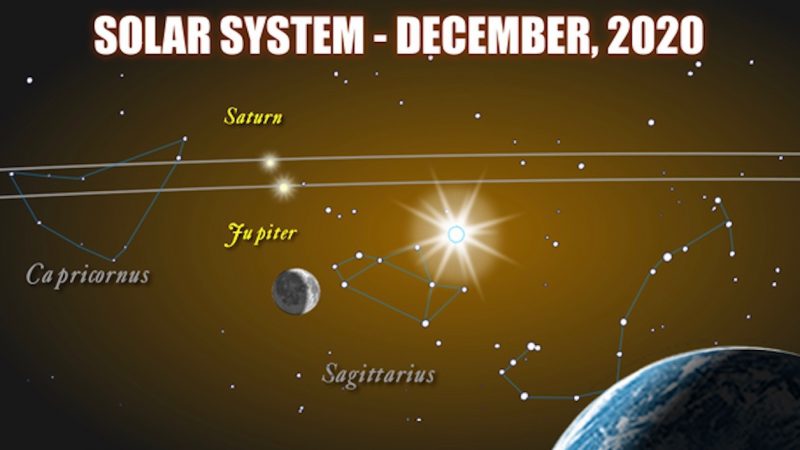
Reprinted with permission from Jay Ryan at ClassicalAstronomy.com
Editor’s Note: Astronomers use the word conjunction to describe meetings of planets and other objects on our sky’s dome. When two objects are in conjunction in our sky, they are located along the same line of sight in space, as viewed from Earth. Jupiter and Saturn have a conjunction about every 20 years. The next one will be December 21, 2020. Between now and then … watch Jupiter and Saturn draw close together in our sky!
Jupiter has been dominating the evening sky all summer. If you’ve never spotted Jupiter before, you might be surprised by the blazing, brilliant brightness of this object. The planets are among the brightest “stars” in the night sky, and Jupiter is the fourth brightest object visible from the Earth, after the sun, moon and Venus. If you’re in the Northern Hemisphere, look for Jupiter above the southern horizon in the early evening sky after night falls; if you’re in the Southern Hemisphere, look closer to overhead. You can’t miss Jupiter; it is brighter than any star. Jupiter is currently passing through the constellation Scorpius, and is to the upper left of the bright star Antares in Scorpius.
Also sharing the evening sky with Jupiter in the current season is the planet Saturn, currently passing through the constellation Sagittarius, the next constellation to the east from Scorpius. Saturn is not as bright as Jupiter, but it’s still comparable in brightness to the brightest stars in the sky.
Saturn is an amazing object in even small amateur telescopes since its famous rings are easy to see. Jupiter itself is also very cool, with the four Galilean moons readily visible in even the smallest scopes. While it’s still summer, everyone should visit a local astronomy club, planetarium or observatory to see these objects. These organizations all have public events where families can visit and look through ‘scopes. Check out this searchable database from Sky & Telescope magazine to find one in your area.
One of the features of the planets is that they all lie along the ecliptic, which is a circle in the sky that roughly corresponds to the plane of the solar system. So each month, the moon passes by each of the planets. Since Jupiter and Saturn are currently so close together, look for the moon to pass between these planets over a span of successive evenings. Here’s how the scene appeared last month, in July 2019.
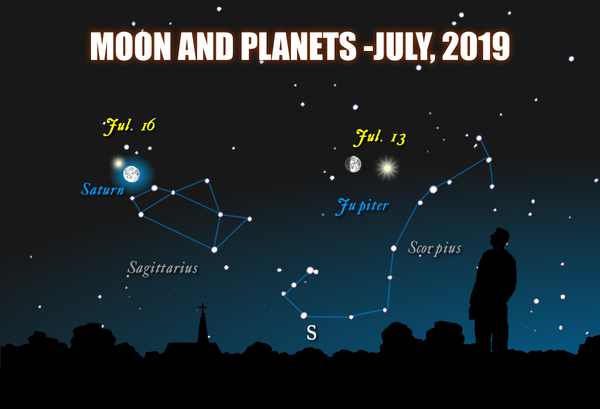
A similar scene will repeat this month, when the waxing gibbous moon passes near Jupiter on the evening of Friday, August 9. On the next day, Saturday, the moon will appear between Jupiter and Saturn. By Sunday evening, August 11, the moon will have shifted further to the east, appearing to draw close to Saturn. The moon’s conjunction (or closest alignment) with Saturn will occur many hours later, when it is daytime over the U.S. Observers in the Pacific, including Australia and New Zealand, will see an occultation of Saturn by the moon, which happens when the moon’s face passes over the planet, blocking the view for a time.
Read more: Moon, Jupiter, Saturn … Perseid meteors?
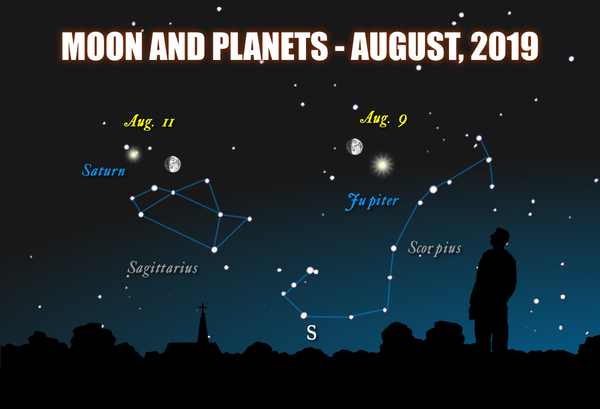
Keep your eyes on the moon and planets through the next month when you’ll see another pair of lunar-planetary conjunctions in September. The first quarter moon draws close to Jupiter on the evening of Thursday, September 5, and the gibbous phase is seen on either side of Saturn on the following Saturday and Sunday, September 7 and 8.
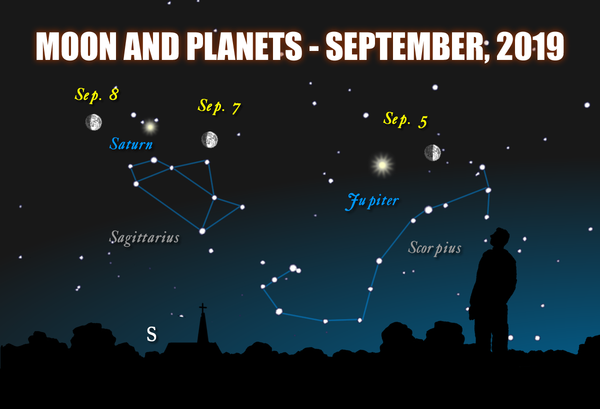
If you’ve been following Jupiter and Saturn over the last several years, you may now notice that these planets were not so close together in recent times. Due to the movements of the planets in their orbits, Jupiter and Saturn are slowly drawing into alignment with each other. This is because of the relative speeds of their orbits.
According to Kepler’s Laws of Planetary Motion, planets move faster in their orbits if they are closer to the sun. Conversely, the further a planet is away from the sun, the slower it moves.
Jupiter is quite far from the sun at five astronomical units, and a “year” on Jupiter is as long as 12 Earth years. So Jupiter is seen passing through the zodiac at the leisurely rate of one constellation to the east per year. This is why Jupiter was passing through Libra last year and is now in Scorpius in 2019.
Saturn is nearly twice as far from the sun as Jupiter, 9.5 astronomical units, and thus the Saturn “year” is 29.5 years in length. Saturn therefore requires more than two years to move through a single zodiac constellation.
At this rate, Jupiter “catches up” with Saturn after a span of years. About every 20 years, Jupiter and Saturn line up in a rare planetary conjunction. When that happens, Jupiter and Saturn are lined up with each as seen from the sun.
The conjunction of Jupiter and Saturn will occur on December 21, 2020. At that time, these planets will line up quite close to the sun, as seen from the Earth. They will be low in the sunset sky.
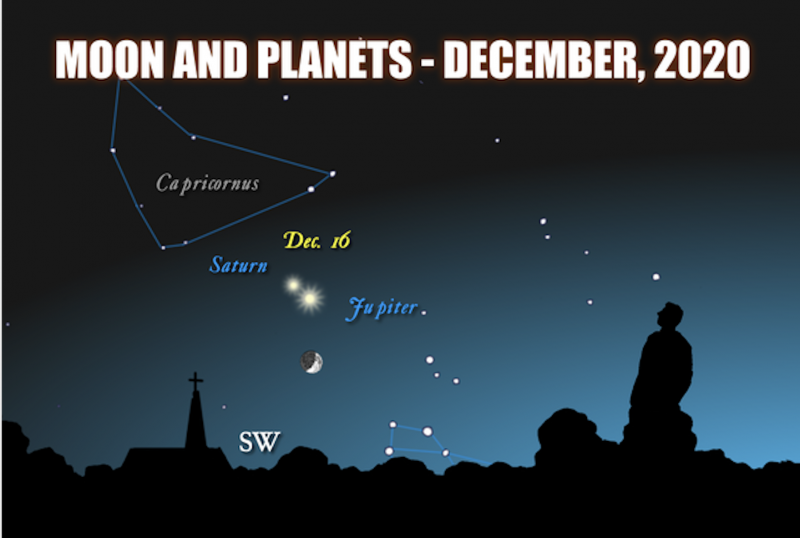
Over the coming year, Jupiter and Saturn will be steadily moving closer and closer toward convergence. During the summer of 2020, it should be a lot of fun to watch these two planets draw together into alignment. By December 2020, this planetary pair will be hanging low in the evening sky, soon to disappear into the sunset. On the evening of December 16, 2020, the waxing crescent moon will align with these planets, making an amazing sight in the twilight sky on the threshold of winter.
Jupiter and Saturn last aligned on May 21, 2000. After the date of conjunction in 2020, Jupiter will progress to the east and draw further and further away from Saturn throughout the decade of the 20s. After that, the two planets will approach each other through the 2030s, reaching conjunction again on November 5, 2040.
Beyond that, Jupiter-Saturn conjunctions will occur on April 10, 2060, March 15, 2080, and September 24, 2100. This is something to discuss with your grandchildren! But for those of us “of a certain age,” the 2020 conjunction might be our last chance to see Jupiter and Saturn align!
It’s not too early to circle that date on your calendar!
Bottom line: Watch for Jupiter and Saturn in the night sky. They are well placed for viewing in the evening now as seen from the entire Earth. Jupiter is brighter than any star. In the coming months, these two bright planets will draw closer. Their conjunction will come in December of 2020, when they’ll appear low in the west after sunset.











